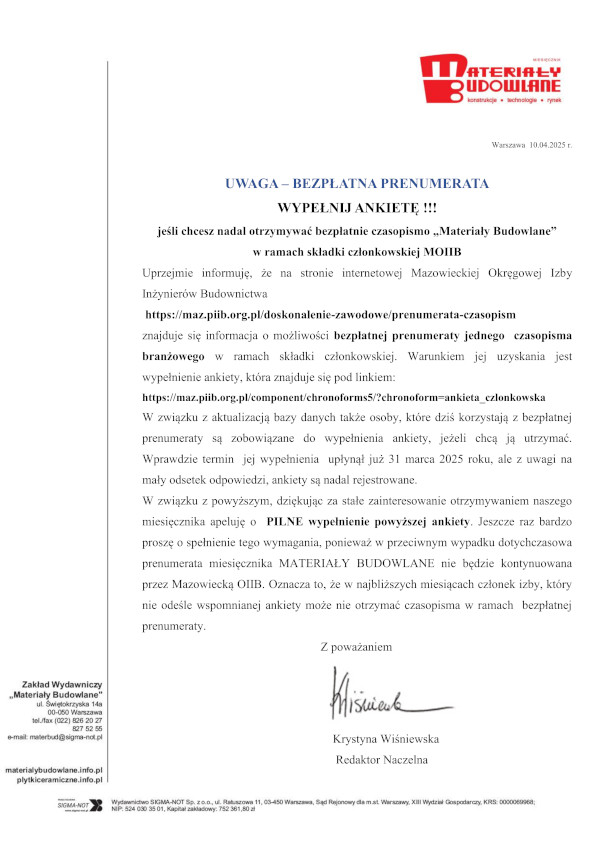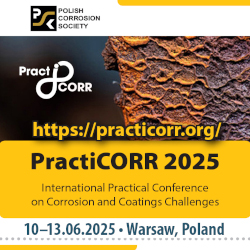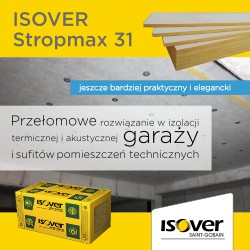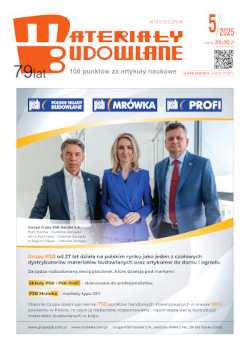dr hab. inż. Grzegorz Ludwik Golewski Politechnika Lubelska, Wydział Budownictwa i Architektury
Autor do korespondencji e-mail : Ten adres pocztowy jest chroniony przed spamowaniem. Aby go zobaczyć, konieczne jest włączenie w przeglądarce obsługi JavaScript.
DOI: 10.15199/33.2015.11.66
W artykule przedstawiono wyniki badań odporności na pękanie betonów z dodatkiem krzemionkowych popiołów lotnych (pl), określane wg pierwszego modelu pękania.Analizie poddano kompozyty betonowe z dodatkiem: 0, 20 i 30% pl. Badania odporności na pękanie przeprowadzono na prasie MTS 810. Oceniano wpływ dodatku pl na wartość parametru KIc S. Analiza uzyskanych wyników badań wykazała, że 20%dodatek pl powoduje wzrost KIc S, natomiast dodatek 30% pl spadek odporności na pękanie. Dodatkowo przedstawiono praktyczne możliwości wykorzystania systemu ARAMIS do makroskopowej oceny propagacji pęknięć w betonach.
Słowa kluczowe: kompozyt betonowy, popiół lotny, kształt rysy, mechanika pękania, systemARAMIS.
* * *
Macroscopic evaluation fracture processes in fly ash concretes
This paper presents the results of fracture toughness tests of concrete with siliceous fly ash (FA), specified at the Mode I fracture. Concrete composites with the additives of 0%, 20% and 30% siliceous FA were analysed. Fracture toughness tests were performed on MTS 810 testing machine. The studies examined effect of FA additive on the parameter KIc S.The Analysis of the results revealed that a 20% FA additive causes increase in KIc S, while a 30% FA additive causes decrease in fracture toughness. Additionally the research results demonstrate the possibilities of practical application of ARAMIS systemfor analysing the development of defects in the structure of concretes containing FA additives. This system can be useful for macroscopic estimation of crack propagation.
Keywords: concrete composite, fly ash, shape of crack, fracture mechanics, ARAMIS System.
.
Literatura :
[1] Meyer C.: The greening of the concrete industry. Cement and Concrete Composites, 31, 2009, 601 – 605.
[2] Haustein E., Quant B.: Wpływ mikrosfer – frakcji odpadów paleniskowych – na mikrostrukturę i wybrane właściwości betonu. Materiały Budowlane, 1/2014, 50 – 53.
[3] Ajdukiewicz A.: „Zielony beton” w konstrukcjach – aspekty materiałowe i technologiczne. Materiały Budowlane, 12/2012, 2 – 6.
[4] Ajdukiewicz A.: „Zielony beton” w konstrukcjach – aspekty projektowe i przykłady. Materiały Budowlane, 1/2013, 76 – 79.
[5] Giergiczny Z.: Dodatki mineralne – niezastąpione składniki współczesnego cementu i betonu. Materiały Budowlane, 3/2009, 46 – 50.
[6] Sadowski T., Golewski G. L., Effect of aggregate kind and graining on modeling of plain concrete under compression. Computational Materials Science, 43, 2008, 119 – 126.
[7] Golewski G. L.: Analiza procesów pękania w kompozytach betonowych z dodatkiem popiołów lotnych.Materiały Budowlane 11/2011, 39 – 42.
[8] Golewski G. L., Golewski P., Sadowski T.: Numerical modeling crack propagation under Mode II fracture in plain concretes containing siliceous fly ash additive using XFEM method. Computational Materials Science, 62, 2012, 75 – 78.
[9] Golewski G. L.: Odporność na pękanie a mikrostruktura w betonach z dodatkiem popiołów lotnych. Materiały Budowlane, 10/2013, 28 – 30.
[10] Lam L., Wong Y. L., Poon C. S.: Effect of fly ash and silica fume on compressive and fracture behaviors of concrete. Cement and Concrete Research, 28, 1998, 271 – 283.
[11] Bharatkumar B. H., Raghuprasad B. K., Ramachandramurthy D. S., Narayanan R., Gopalakrishnan S.: Effect of fly ash and slag on the fracture characteristics of high performance concrete. Materials and Structures, 38, 2005, 63 – 72.
[12] Tang W. C., Lo T. Y., Chan W. K.: Fracture properties of normal and lightweight high-strength concrete. Magazine of Concrete Research, 60, 2008, 237 – 244.
[13] Vejmelkova E., Pavlikova M., Keepert M., Kersner Z., Rovnanikova P., Ondracel M., Sendlmajer M., Cerny R.:Wpływ popiołu lotnego na właściwości BWW. Cement Wapno Beton, 4, 2009, 189 – 204.
[14] Roesler J., Paulino G. H., Park K., Gaedicke C.: Concrete fracture prediction using bilinear softening. Cement and Concrete Composites, 29, 2007, 300 – 312.
[15] Konkol J., Pokropski G.:Wpływ wieku betonów z dodatkiem popiołu fluidalnego lub metakaolinitu na ich właściwości wytrzymałościowe. Drogi i Mosty, 13, 2014, 49 – 67.
[16] Determination of fracture parameters (KIc and CTODc) of plain concrete using three-point bend tests. RILEM Draft Recommendations, TC 89-FMT Fracture Mechanics of Concrete Test Methods. Materials and Structures, 23, 1990, 457 – 460.
[17] Guinea G. V., Planas J., Elices M.: Measurement of the fracture energy using three point bend tests: Part 1–Influence of experimental procedures. Materials and Structures, 25, 1992, 212 – 218.
[18] Prokopski G., Langier B.: Effect of water/cement ratio and silica fume addition on the fracture toughness and morphology of fractured surfaces of gravel concretes. Cement and Concrete Research, 30, 2000, 1427-1433.
[19] Glinicki M. A., Litorowicz A., Zieliński M.: Badanie fibrobetonów na pękanie przy zginaniu. Materiały Budowlane, 3/2002, 74 – 76.
[20] Wu Z., Rong H., Zheng J., Xu F., Dong W.: An experimental investigation on the FPZ properties in concrete using digital image correlation technique. Engineering Fracture Mechanics, 78, 2011, 2978 – 2990.
[21] Skarżyński Ł., Syroka E., Tejchman J.: Measurements and calculations of the width of the fracture process zones on the surface of notched concrete beams. Strain, 47, 2011, e319 – e332.
[22] Alam S. Y., Saliba J., Loukili A.: Fracture examination in concrete through combined digital image correlation and acoustic emission techniques. Construction and Building Materials, 69, 2014, 232 – 242.
[23] Bascoul A., Turatsinze A.: Microstructural characterization of mode I crack opening in mortar. Materials and Structures, 27, 1994, 71 – 78.
Otrzymano: 29.09.2015 r.
Materiały Budowlane 11/2015, str. 210-212 (spis treści >>)





























